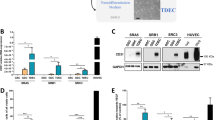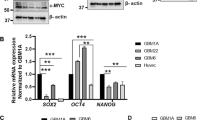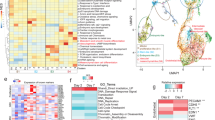Abstract
Glioblastoma multiforme, the most common brain tumor, typically exhibits markedly increased angiogenesis, which is crucial for tumor growth and invasion. Antiangiogenic strategies based on disruption of the tumor microvasculature have proven effective for the treatment of experimental brain tumors. Here, we have overexpressed human caspase-9 by stable transfection in the SNB19 glioblastoma cell line, which normally expresses low levels of caspase-9. Our studies revealed that overexpression of caspase-9 coupled with radiation has a synergistic effect on the inhibition of glioma invasion as demonstrated by Matrigel assay (>65%). Furthermore, sense caspase stable clones cocultured with fetal rat brain aggregates along with radiation showed complete inhibition as compared to the parental and vector controls. During in vitro angiogenesis, SNB19 cells cocultured with human microvascular endothelial cells (HMEC) showed vascular network formation after 48–72 h. In contrast, these capillary-like structures were inhibited when HMEC cells were cocultured with sense caspase stable SNB19 cells. This effect was further enhanced by radiation (5 Gy). Signaling mechanisms revealed that apoptosis is induced by cleavage of caspase-9 by radiation, loss of mitochondrial membrane potential and activation of caspase-3. These results demonstrate that activation of caspase-9 disrupts glioma cell invasion and angiogenesis in vitro. Hence, overexpression of proapoptotic molecules such as caspase-9 may be an important determinant of the therapeutic effect of radiation in cancer therapy.
This is a preview of subscription content, access via your institution
Access options
Subscribe to this journal
Receive 50 print issues and online access
$259.00 per year
only $5.18 per issue
Buy this article
- Purchase on Springer Link
- Instant access to full article PDF
Prices may be subject to local taxes which are calculated during checkout










Similar content being viewed by others
Abbreviations
- VEGF:
-
vascular endothelial growth factor
- HUVEC:
-
human umbilical vascular endothelial cells
- GBMs:
-
glioblastoma multiforme
- PBS:
-
phosphate buffered saline
- DiI:
-
1′-dioctadecyl-3,3,3′,3′-tetramethylindocarbocyanineperchlorate
- DiO:
-
3,3′-dioctadecyloxacarbocyanine perchlorate
- ECM:
-
extracellular matrix
References
Bae SN, Arand G, Azzam H, Pavasant P, Torri J, Frandsen TL and Thompson EW . (1993). Breast Cancer Res. Treat., 24, 241–255.
Belka C, Heinrich V, Marini P, Faltin H, Schulze-Osthoff K, Bamberg M and Budach W . (1999). Int. J. Radiat. Biol., 75, 1257–1264.
Belka C, Rudner J, Wesselborg S, Stepczynska A, Marini P, Lepple-Wienhues A, Faltin H, Bamberg M, Budach W and Schulze-Osthoff K . (2000). Oncogene, 19, 1181–1190.
Bergmann A, Agapite J and Steller H . (1998). Oncogene, 17, 3215–3223.
Boldin MP, Goncharov TM, Goltsev YV and Wallach D . (1996). Cell, 85, 803–815.
Chinnaiyan AM, Orth K, O'Rourke K, Duan H, Poirier GG and Dixit VM . (1996). J. Biol. Chem., 271, 4573–4576.
Duan H, Chinnaiyan AM, Hudson PL, Wing JP, He WW and Dixit VM . (1996). J. Biol. Chem., 19;271, 1621–1625.
Durand RE and Sutherland RM . (1972). Exp. Cell Res., 71, 75–80.
Eshleman JS, Carlson BL, Mladek AC, Kastner BD, Shide KL and Sarkaria JN . (2002). Cancer Res., 62, 7291–7297.
Giese A and Westphal M . (2001). J. Cancer Res. Clin. Oncol., 127, 217–225.
Go Y, Chintala SK, Mohanam S, Gokaslan Z, Venkaiah B, Bjerkvig R, Oka K, Nicolson GL, Sawaya R and Rao JS . (1997). Clin. Exp. Metastasis, 15, 440–446.
Green DR and Reed JC . (1998). Science, 281, 1309–1312.
Hengartner MO and Horvitz HR . (1994). Cell, 76, 665–676.
Kluck RM, Bossy-Wetzel E, Green DR and Newmeyer DD . (1997). Science, 275, 1132–1136.
Labrousse F, Daumas-Duport C, Batorski L and Hoshino T . (1991). J. Neurosurg., 75, 202–205.
Li P, Nijhawan D, Budihardjo I, Srinivasula SM, Ahmad M, Alnemri ES and Wang X . (1997). Cell, 91, 479–489.
Los M, Wesselborg S and Schulze-Osthoff K . (1999). Immunity, 10, 629–639.
Maher EA, Furnari FB, Bachoo RM, Rowitch DH, Louis DN, Cavenee WK and DePinho RA . (2001). Genes Dev., 15, 1311–1333.
Majack RA and Clowes AW . (1984). J. Cell Physiol., 118, 253–256.
Melchiori A, Allavena G, Bohm J, Remy W, Schmidt J, Parodi S, Santi L and Albini A . (1987). Anticancer Res., 7, 475–479.
Mohanam S, Sawaya R, McCutcheon I, Ali-Osman F, Boyd D and Rao JS . (1993). Cancer Res., 53, 4143–4147.
Motyl T . (1999). Reprod. Nutr. Dev., 39, 49–59.
Murugesan G, Chisolm GM and Fox PL . (1993). J. Cell Biol., 120, 1011–1019.
Muzio M, Chinnaiyan AM, Kischkel FC, O'Rourke K, Shevchenko A, Ni J, Scaffidi C, Bretz JD, Zhang M, Gentz R, Mann M, Krammer PH, Peter ME and Dixit VM . (1996). Cell, 85, 817–827.
Nor JE, Hu Y, Song W, Spencer DM and Nunez G . (2002). Gene Ther., 9, 444–451.
Onda K, Davis RL, Shibuya M, Wilson CB and Hoshino T . (1994). Cancer, 74, 1921–1926.
Pan G, O'Rourke K and Dixit VM . (1998). J. Biol. Chem., 273, 5841–5845.
Pedersen PH, Marienhagen K, Mork S and Bjerkvig R . (1993). Cancer Res., 53, 5158–5165.
Porter AG and Janicke RU . (1999). Cell Death Differ., 6, 99–104.
Rampling R, Cruickshank G, Lewis AD, Fitzsimmons SA and Workman P . (1994). Int. J. Radiat. Oncol. Biol. Phys., 29, 427–431.
Sarkar R, Meinberg EG, Stanley JC, Gordon D and Webb RC . (1996). Circ. Res., 78, 225–230.
Shinoura N, Sakurai S, Asai A, Kirino T and Hamada H . (2002). Bi. J. Cancer, 86, 587–595.
Soengas MS, Capodieci P, Polsky D, Mora J, Esteller M, Opitz-Araya X, McCombie R, Herman JG, Gerald WL, Lazebnik YA, Cordon-Cardo C and Lowe SW . (2001). Nature, 409, 207–211.
Suit HD, Zietman A, Tomkinson K, Ramsay J, Gerweck L and Sedlacek R . (1990). Int. J. Radiat. Oncol. Biol. Phys., 18, 365–373.
Taghian A, DuBois W, Budach W, Baumann M, Freeman J and Suit H . (1995). Int. J. Radiat. Oncol. Biol. Phys., 32, 99–104.
Uchida H, Shinoura N, Kitayama J, Watanabe T, Nagawa H and Hamada H . (2002). Biochem. Biophys. Res. Commun., 292, 347–354.
Vajkoczy P, Goldbrunner R, Farhadi M, Vince G, Schilling L, Tonn JC, Schmiedek P and Menger MD . (1999). Int. J. Dev. Neurosci., 17, 557–563.
Vaux DL and Korsmeyer SJ . (1999). Cell, 96, 245–254.
Wolf BB and Green DR . (1999). J. Biol. Chem., 274, 20049–20052.
Yang J, Liu X, Bhalla K, Kim CN, Ibrado AM, Cai J, Peng TI, Jones DP and Wang X . (1997). Science, 275, 1129–1132.
Yuan JY and Horvitz HR . (1990). Dev. Biol., 138, 33–41.
Zou H, Henzel WJ, Liu X, Lutschg A and Wang X . (1997). Cell, 90, 405–413.
Acknowledgements
We thank Karen Minter for preparing the manuscript and Sushma Jasti and Diana Meister for manuscript review. This work was supported by National Cancer Institute Grant CA 75557, CA 85216, CA 92393, CA 95058 and NINDS NS 47699 (to JSR).
Author information
Authors and Affiliations
Corresponding author
Rights and permissions
About this article
Cite this article
Yanamandra, N., Kondraganti, S., Srinivasula, S. et al. Activation of caspase-9 with irradiation inhibits invasion and angiogenesis in SNB19 human glioma cells. Oncogene 23, 2339–2346 (2004). https://doi.org/10.1038/sj.onc.1207406
Received:
Revised:
Accepted:
Published:
Issue Date:
DOI: https://doi.org/10.1038/sj.onc.1207406
Keywords
This article is cited by
-
Systematic transcriptome profiling of pyroptosis related signature for predicting prognosis and immune landscape in lower grade glioma
BMC Cancer (2022)
-
The effect of silver nanoparticles (AgNPs) on proliferation and apoptosis of in ovo cultured glioblastoma multiforme (GBM) cells
Nanoscale Research Letters (2015)
-
The Apaf-1•procaspase-9 apoptosome complex functions as a proteolytic-based molecular timer
The EMBO Journal (2009)



